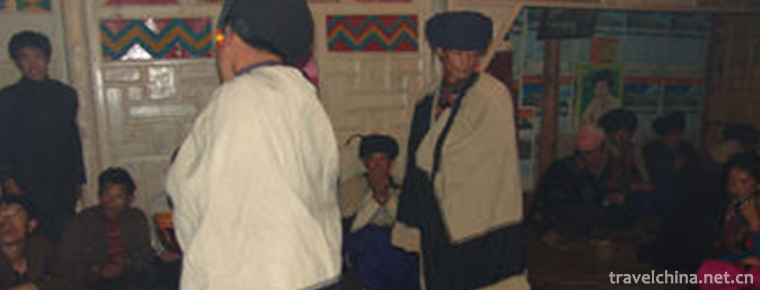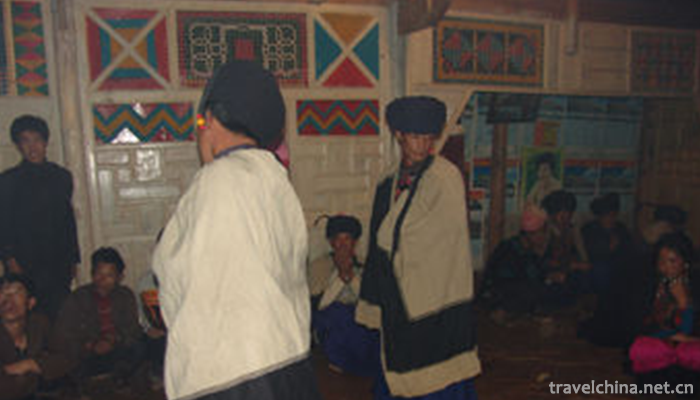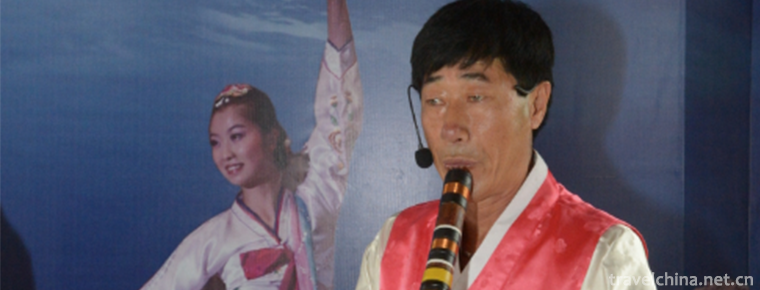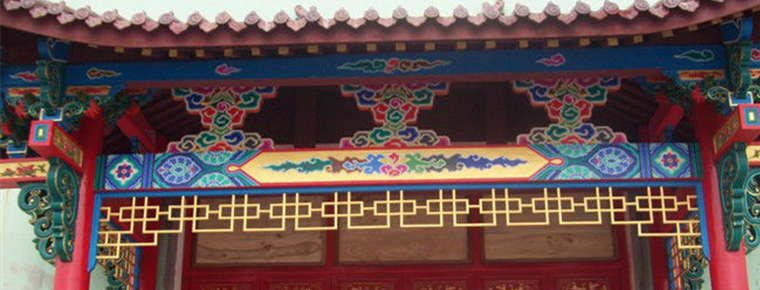2018-12-12

- By ChinaWiki.net
- Chinese Edition
- 2019-07-12
Yi Kezhi
Yi Kezhi is a popular oral literature of poetry style among the Yi people. It is the cultural accumulation formed by the Yi people in their long-term production and life, and has a very long history. Its narrative content is all-encompassing, its poetic language is easy to understand, its artistry is strong, and its recitation is easy to remember.
On June 7, 2008, Yis Kezhi was listed in the second batch of national intangible cultural heritage list with the approval of the State Council.
Historical Origin
The Yi people's "Kezhi" is also called "Kezhi Haju". It is a unique poem-style literature with a fixed format. It is one of the oral literature with a long history, which is widely spread among the Yi people. Ke Zhiwen is rich in content, lyric, narrative and vivid in form. Kezhi literary style is mainly performed on occasions of marrying a wife and marrying a daughter. It represents the people who attend the wedding on behalf of both the male and female parents. It takes the host and the guest as its opponents, and chooses the people who can speak well, think quickly and have rich knowledge as their representatives. Both sides are fighting with Kezhi while drinking good wine. In order to overwhelm their opponents, they use a lot of metaphors respectively. The language is exaggerated, fluent and musical.
primary coverage
"Kezhi" has a wide range of contents, various forms, lyric, narrative and other lively. "Kezhi" mostly performs on wedding and funeral occasions and on New Year's Day. During the performance, the host and the guest choose their own representatives who can speak and speak wisely, and use a lot of metaphors to exaggerate, fluently and freely with themselves.
Opponent debate.
In the course of Kezhi's progress, the two sides are tit-for-tat, sometimes attacking, sometimes defending. Sometimes they charge, sometimes they retreat, sometimes they surge, sometimes they are calm. Some overnight disputes are difficult to win or lose until dawn. Finally, the old man takes the wine to persuade them. They often say, "Stop, there are many girls. Your wisdom will be saved for other girls'wedding. "
When speaking of wisdom, the host and the guest confront each other, and each defends his opponent's content one by one, comparing wisdom with knowledge. Sometimes ancient history, sometimes the sea and sky. In order to overcome the strain of the smart phone, we need to be quick-witted, play freely and create improvisations. The audience was attentive and silent. When it comes to excellence, we win cheers from time to time. "Kezhi" can play the role of education and propaganda to stimulate the masses and entertainment.
"Kezhi" is different from the counterpart and crosstalk of Quyi. The Yis'Kezhi is represented by the guests and hosts of both parties. After a paragraph is finished, the Yi responds to the content of the statement of A by B. In each round, there are more than fifty lines and less than twenty or thirty lines.
Said that Kezhi mostly carried out by the fire pond, with the fire pond as the center, guests above, the host below, and drinking performances in person. The audience sat around, with both the host and the guest watching closely and hoping that their representatives would win. If the host wins, the host will say, "Ke Zhi says that you can't take our girl away if you don't win. "If the guest wins, the guest will also be amused to say:" We are more knowledgeable than others, and it is really not possible to be friendly with us. "Therefore, in order to get married, we must first choose a smart hand to pick up the marriage, or we will be threatened by splashing water and smearing our faces.
"Kezhi" is a kind of poetry of Yi nationality, and it has rhymes. "Kezhi" pays attention to harmony and harmony in rhythm and rhythm, and emphasizes the importance and urgency of tone. "Erbi" means that proverbs are fully used in "Kezhi". The short, concise and flexible "Erbi" is very active in Kezhi and plays a key role.
Although "Kezhi" is flexible and flexible, it is not disorderly, let alone rambling about. It is organized and expressed from the shallow to the deep, i.e. in the order of opening remarks, personal questions, gradual deepening, development, turning point, development, climax, easing and ending.
The sequence of "Kezhi" is not fixed, it can only be said that it is generally carried out in accordance with these steps. Content also varies with time, place and performer. The content of the dialogue changes with the place. If the wedding ceremony is held, in the female party A is the guest, B is the host; in the male party, A is the host, B is the guest.
The dialogues between the two sides are organically linked, and they are two aspects of a whole. They can't be independent words, questions and answers, and they can't be professionals.
Such as A:
I am a big tree on the hill.
Can withstand the cold wind blowing;
I am the reef by the Jinsha River.
Can withstand the impact of waves.
B: I am Leigong in the sky.
Specializing in splitting the big trees on the mountain;
I'm a stone worker.
Specialize in hitting the reefs by the river.
Like A:
I am like a ruthless rolling stone.
Running downhill;
B: I'm like a big ditch.
Hold the rolling stones.
Every round must be closely linked, coincide with each other, ring tightly, but it is not mechanically constrained in these links. In the middle of the journey, we can change the conversation and turn, or fly over, from the ground to the sky. From east to west to North and south. Almost all of this is done in a tone twist.
"Kezhi" has a wide range of contents, including astronomy, geography, ancient and modern history, etc. It can be said that "wisdom" is an all-embracing "encyclopedia". Such as: praise the famous inventors of ancient and modern times, the warriors who wipe out harm for the people, the people who have done good deeds for mankind and their deeds are doubly praised. In "Kezhi", we can talk about "Leo" or "epic", "Mamu" or "Ancient Xunshi Poetry", as well as ancient world-breaking, heroic epic, conquering all things, etc. Not only can everyone enjoy beauty, but also he can increase his knowledge of history. There are also many philosophical precepts, with clear love and hatred, which praise the good and criticize, criticize and satirize the bad. It also involves the norms of human moral behavior, the praise of truth, goodness and beauty, and the criticism of falsehood, evil and ugliness. "Kezhi", the inherent folk oral literature form of the Yi people, can give people a lot of lessons.
"Kezhi" has a wonderful language, vivid metaphor, rich imagination and strong artistic color, which makes people feel great interesting. Its artistic interest, can spontaneously attract the broad audience, with exaggerated, humorous, funny language, enhance the happy atmosphere of happy occasions, Festival happiness, funeral occasions depression.
The basic expressive feature of "Kezhi" art is exaggeration, which has a strong romantic color. Every "smart" competition has new content, because the performers are not prepared for the performance beforehand, but rely on the process of the dialogue, based on the content of the other side, to reorganize the content to respond.
"Kezhi" has a strong pertinence, and its narrative content is extremely extensive. Whoever is drawn from, it must be related to the content and object of the recitation. In spite of the ever-changing nature, the world is far from the north, and the castles in the air, eventually it has to settle on the topic of mutual discussion.
The performance and creation of "Kezhi" should be optimistic. As mentioned above, the main method of "Kezhi" creation is exaggeration. Therefore, the performer himself should have optimism, fearlessness, all contradictions seem to be insurmountable in front of him, and because of its humorous and interesting characteristics, not only should the audience express themselves in the performance.
Laugh, laugh yourself. The depressed performer, no matter how hard he tries, can't say "wit", that is to say, some will lose their standard.
"Kezhi" is rich in imagination, which is also a major feature of it. These imaginations come from life, but higher than life. Without a deep foundation of life, it is impossible to have rich imagination, refine and process from life, condense exquisite and vivid metaphors to constitute wisdom, rather than rigid and rigid.
Every time there is a smart show, there will be a lot of new content. Ke Zhi's creation is both collective and individual. On the basis of individual creation, it is processed and modified collectively. Because it is improvised in Yin Chung Competition, it can effectively respond to the other side's content, give answers or counter-attacks. Competition wit, each time in the recitation contest to see scenery sentiment, anxious to create intellectually. Therefore, it is recognized or resonated by the masses, so that it can be used as ready-made words in similar contest environment. In the long history of history, the creation of Chi Chi performances has improved and enriched the wisdom itself. However, because of the lack of collection and recording of self destruction and self destruction, what is often used by people is simply some memorable essence.
Manifestation
Kezhi is the transliteration of Yi language. "Ke" means "mouth" and "mouth", while "Zhi" means moving, relocating and yielding. The name "Kezhi" indicates that "Kezhi" has the characteristics of verbal and flexible mobility. This is oral creation, oral performance and one of the Yis'oral literature.
"Kezhi" is called "Keshihaju". "Keshi" means exaggeration, and "Haju" has a flexible tongue and clever words. This name is named from the characteristics of the creative method of "Kezhi". "Ke Zhi" is also known as "Ke Ge Ha Cha", "Ke Ge" is the meaning of joking. This is named after the entertainment and interesting characteristics of "intelligence". "Kezhi" is also known as "Keboha Risk", that is, the meaning of debate and confrontation. "Kezhi" is also known as "Kewei", that is, marginal language, introductory remarks. The word "Ke" is inseparable from several names of "Ke Zhi" of the Yi nationality. This reflects the oral characteristics of the Yi people's "wit". It has been proved that in a long historical period, oral language has been used to disseminate and create "Kezhi" works, and oral creation and dissemination have been familiar to the Yi people in the way of "oral imparting heart" so that they can spread widely and endure for a long time.
Inheritance Significance
The fine tradition of "wit" in oral creation has not disappeared even in today's highly developed writing tools and publishing conditions. This is because oral language itself is the most convenient expression tool, which is easy to pass on and remember. "Kezhi" is closely attached to all aspects of Yi people's life, firmly engraved in the memory of the people. The people reflect their lives and struggle in spoken language, which is extremely timely and convenient. People's oral creation is inseparable from the superiority of oral language expression.
Kezhi, a folk oral literary creation technique, has emerged in endlessly, constantly pushing out the old and bringing forth the new, giving new contents under the new historical conditions. Over the past 40 years since liberation, we have inherited and developed the excellent legacy of "Kezhi", and created new works according to the characteristics of this form, serving our socialist modernization construction and playing a positive role in publicizing and encouraging people to move forward.
"Kezhi" is not limited by space and time. Its performance does not need any stage and many actors. It is very suitable for performances in rural areas, especially in remote mountainous areas. It has many other literary and artistic functions that can not be played, local materials, rich in national characteristics. It plays an irreplaceable role and far-reaching significance in enriching and activating Yi's rural literary and artistic life.

Ask a Question
Your email address will not be published.



0 Questions